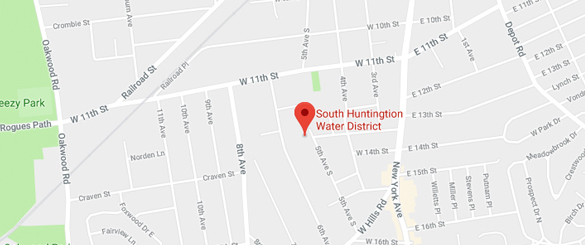Q. What do I need to do if I am selling or purchasing a home in the district?
A. Please call our office at 631-427-8190 with the following information ready:
- Your account number
- Service (current home) address
- Seller’s forwarding address
- Purchaser’s name
- Date of closing
- Please call our office for a final meter reading
Q. What affects water consumption the most?
A. Several factors affect water consumption, and as a result, your water bill. Chief among them are weather, home conditions and leaks.
- Weather: Water consumption typically changes on a seasonal basis. Most people use less water during the cooler months than in the summer. Frequent watering of lawns and gardens increases usage. If you have a sprinkler system, your usage and bill will be higher during the months of its use.
- Living Conditions: Have you made changes or improvements to your home? Expansion (e.g., adding an apartment, bathroom, etc) will increase usage. And, of course, the more people living in your home, the more usage. Consequently, you’re likely to receive a higher bill.
- Leaks: Check your home for leaks. Little things add up. For example, a dripping faucet can account for substantial increases in water usage over time. Even a toilet tank leak can add up to higher bills.
Q. Why do I have to pay for water that results from a leak?
A. The consumer is responsible for all the water that passes through the water meter including water caused by a leaking meter.
Q. What is the average bill?
A. Each consumer’s usage is determined by different variables including the number of people living in the home and their use of water. In addition, the way the lawns are watered and other uses of water also affect a bill. For these reasons, we are unable to give a meaningful average. Additionally, water consumption typically changes from season to season.
Q. Why is this bill higher than the last bill I received?
A. Many factors can contribute to fluctuations in your water bill. Extreme weather conditions such as a drought or heavy rainfall the previous year can be a factor. Additionally, water consumption typically changes from one season to the next. For an accurate comparison, examine bills from corresponding periods of previous years, while considering rainfall recorded. An increase in the number of people living in the residence can be a factor. Another culprit could be a leak. Dripping faucets inside and outside are obvious sources, but look for other less visible signs as well. Listen for hissing noises around the toilet, which could indicate a shut-off valve is leaking. An underground sprinkler system is another area to check. Leaks can add up. For example, a hole that’s 1/16″ wide can leak as much as 74,000 gallons of water in 90 days.
Q. Will I receive a bill if I used no water?
A. Even if no water was used during a quarterly period, a minimum charge bill will be rendered.
Q. Do you accept payments over the telephone?
A. No, payments cannot be made over the phone at this time. Payments can be mailed to: PO Box 71458, Philadelphia, PA 19176-1458. Please be sure to include your account number on your check. You may also pay your bill at our office located at 75 5
th Avenue South, Huntington Station, NY 11746 between the hours of 8:30 AM to 4:30 PM, Monday through Friday. Check or cash only is accepted at the office. For your convenience, we have also added a Pay Your Bill Online feature, which you can access in the
billing section of our website.
Q. Why do I have to pay a new owner or final bill fee?
A. A new owner or final bill fee are specific charges used to defray the costs incurred to establish a new service or discontinue a service. Also, in order to keep service costs low for our customers, we established these fees to cover costs associated with new infrastructure and maintaining wells.



